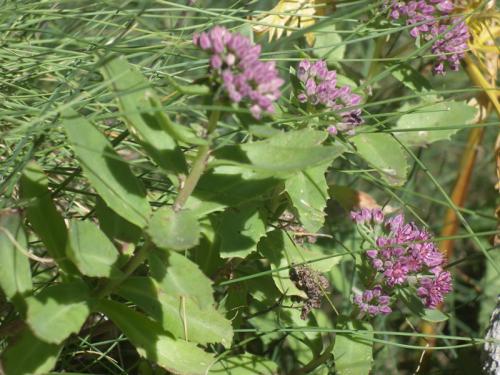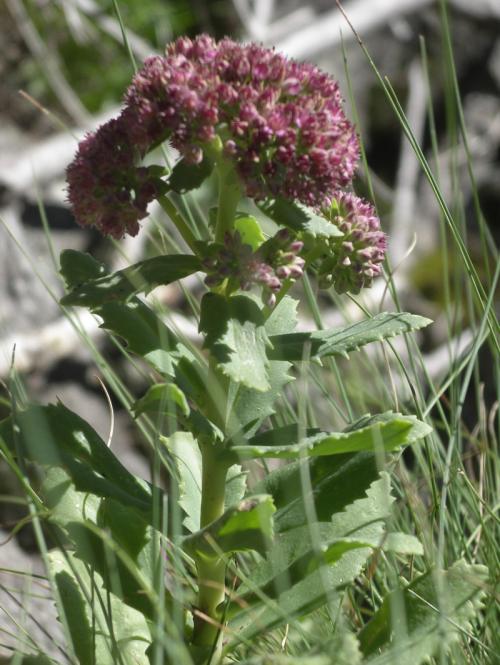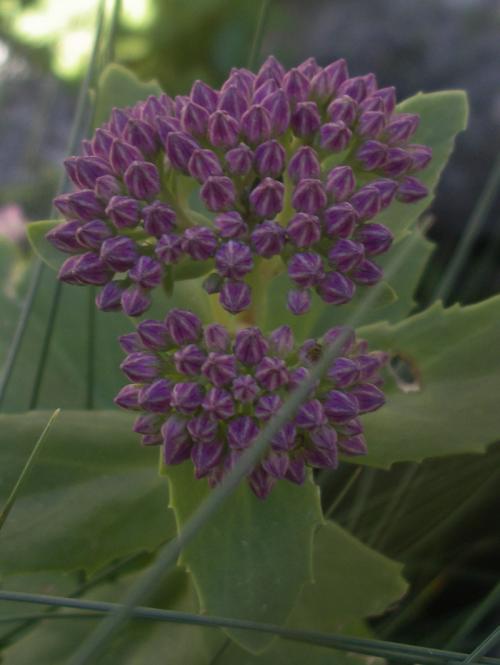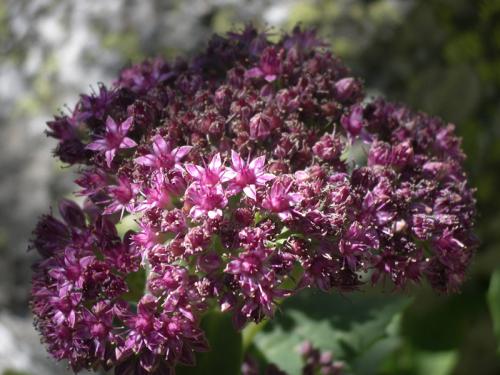TELEPHIUM ssp. TELEPHIUM
Synonyms :
Sedum telephium var. γ L. (1753)
Sedum telephium var. album L. (1753)
Sedum telephium var. purpureum L. (1753) / Sedum purpureum (L.) Schultes (1814) / Sedum telephium fa purpureum (L.) Rouy & Camus (1901) / Sedum telephium ssp. purpureum (L.) Schinz & Thellung (1909) / Hylotelephium purpureum (L.) Holub (1979)
Sedum complanatum Gilibert (1781)
Anacampseros triphylla Haworth (1812) / Sedum triphyllum (Haworth) Gray (1821) / Hylotelephium triphyllum (Haworth) Holub (1983)
Anacampseros vulgaris Haworth (1812) / Hylotelephium vulgare (Haworth) Holub (1979)
Anacampseros arguta Haworth (1821) / Sedum argutum (Haworth) Sweet (1826) / Hylotelephium argutum (Haworth) Holub (1979)
Sedum vulgare Link (1821) / Sedum telephium ssp. vulgare (Link) Fröderström (1930)
Sedum decumbens Lucé (1823) / Hylotelephium decumbens (Lucé) Byalt (1995)
Sedum guestphalicum Boenninghausen ex Reichenbach (1832)
Sedum fabaria W.D.J.Koch (1837) / Sedum telephium ssp. fabaria (W.D.J.Koch) Kirschleger (1852) / Sedum maximum ssp. fabaria (W.D.J.Koch) Löve (1961) / Hylotelephium telephium ssp. fabaria (W.D.J.Koch) H.Ohba (1977)
Sedum purpurascens W.D.J.Koch (1843) / Sedum telephium var. purpurascens (W.D.J.Koch) D.A.Webb (1961)
Sedum maritimum Boguslaw (1846) / Hylotelephium maritimum (Boguslaw) Grulich (1984)
Sedum bohuslavii Ruprecht (1850)
Sedum carpaticum G.Reuss (1853) / Sedum telephium var. carpaticum (G.Reuss) Domin (1935) / Hylotelephium carpaticum (G.Reuss) Soják (1980) / Hylotelephium argutum ssp. carpaticum (G.Reuss) Dostál (1982)
Sedum telephium var. ochroleucum Neilreich (1859)
Anacampseros aurigerana Jordan & Fourreau (1866)
Anacampseros beugesiana Jordan & Fourreau (1866)
Anacampseros borderi Jordan & Fourreau (1866) / Sedum borderi (Jordan & Fourreau) A. Chevalier (1927)
Sedum jullianum Boreau (1866) / Anacampseros julliana (Boreau) Jordan & Fourreau (1867) / Hylotelephium jullianum (Boreau) Grulich (1984)
Sedum telephium var. borderi Rouy & Camus (1901)
Sedum telephium var. tarnense Rouy & Camus (1901)
Sedum telephium fa. roseo-variegatum Praeger (1921)
Sedum telephium var. occidentale Fröderström (1930)
Sedum mugodsharicum Borissova (1939) / Hylotelephium mugodsharicum (Borissova) Grulich (1984)
Sedum archangelicum Ruprecht ex Borissova (1939)
Hylotelephium buxicola Holub (1984)
Hylotelephium confertum Holub (1984)
Hylotelephium convexum Holub (1984)
Hylotelephium dumeticola Holub (1984)
Hylotelephium lapidicola Holub (1984)
Hylotelephium lugdunense Holub (1984)
Hylotelephium monticulorum Holub (1984)
Hylotelephium navieri Holub (1984)
Hylotelephium praecelsa Holub (1984)
Hylotelephium pycranthum Holub (1984)
Hylotelephium repens Holub (1984)
Hylotelephium rhodanense Holub (1984)
Hylotelephium rubellum Holub (1984)
Hylotelephium rupifragum Holub (1984)
Hylotelephium saxifragum Holub (1984)
Hylotelephium subalbidum Holub (1984)
Hylotelephium viridulum Holub (1984)
Hylotelephium vogesiacum Holub (1984)
Distribution : Europe.
Description (by H. Ohba in IHSP, 2003) :
Rootstock short with numerous fusiform roots.
Leaves alternate or sometimes partly opposite, sessile, oblong or elliptic-ovate to narrowly ovate, 3 - 6 x 1 - 2,5 cm, glabrous, dark green, sometimes tinged red, tip obtuse to acute, base cuneate in lower leaves and sometimes truncate in upper leaves, margins usually strongly dentate.
Inflorescences : Flowering stems erect or ascending (or very rarely pendulous), 30 - 60 cm, inflorescences terminal and sometimes from axils of upper leaves, dense, many-flowered, sepals triangular, ± 2 mm, petals reddish-purple, oblong, 4 - 5 mm, spreading, anthers reddish-brown.
Flowering time : August to September
Cytology : 2n = 36, 48
Most reports of this species from Siberia and eastern Asia (China, Korea, Japan) are referable to H. pallescens.
Ray Stephenson (Sedum, Cultivated Stonecrops, 1994, pp 273 to 275 and 276) :
Hylotelephium telephium ssp. telephium is almost indistinguishable from the English Hylotelephium telephium ssp. fabaria, and, except for a few minor differences, has the same appearance and can be used in the same situations. It is very rare in its true natural form in Britain, but is commonly grown in Japan.
Habitat : This is an exceptionally widespread stonecrop native to lowland meadow margins from central Europe to Japan.
Main points of distinction : Carpels are distinctly grooved on the outer side, and lower leaves (Leaf shapes, fig. 1m), which are not particularly glaucous, are not cuneate (tapered below).
Hylotelephium telephium ssp. fabaria [now included as a synonym] :
Long known in cottage gardens, the English Hylotelephium telephium is often, even in serious florae, confused with garden escapes of more easterly subspecies. It is not a spectacular plant, but one worthy of a place in any border. It becomes a 40-cm (16-in) high, fresh green herb crowded with upward pointing medium-sized leaves and topped with glaucous-violet buds and purple flowers.
Habitat : Widespread throughout west and central Europe, this stonecrop is usually a plant of hedgerows.
Main points of distinction : Dark purple flowers immediately distinguish this subspecies from Hylotelephium telephium ssp. maximum and H. telephium ssp. ruprechtii, but the more easterly H. telephium ssp. telephium is virtually identical. The cytologist can distinguish the two by chromosome counts: H. telephium ssp. fabaria has only 2n = 24, while the more easterly subspecies has counts of 2n = 36 and 2n = 48. The best indicators for the English subspecies are the completely glabrous leaves, which are cuneate below, and the shortly petiolate lower leaves (Leaf shapes, fig. 1g). Carpels have no grooves on the outer side, and leaves are regularly dentate.
Variation : Unless this subspecies has been propagated vegetatively from wild stock, it is likely that hybridization has occurred. Literally dozens of cultivars have been produced, and enthusiastic horticulturists sell seeded offspring, which can be of sharp contrast to the one known parent. 'Munstead Dark Red' [see 'Munstead Red'] is a good example; it has bright red stems and a generous amount of red suffusion throughout, but its seedlings are any color from green to red.
Only one wild form is worthy of mention due to its consistent, distinctive characteristics - Hylotelephium telephium subsp. fabaria var. borderi Rouy & Camus - which is unfortunately now quite a rare variation. It seems to have been replaced in cultivation by Hylotelephium 'Autumn Joy' ['Herbstfreude], though once it was a relatively common tall plant of the cottage garden, carrying distinct narrow leaves with cuneate bases (Leaf shapes, fig. 1h). In other respects it is identical to H. telephium ssp. fabaria. It appears to be susceptible to fungal infection.
Hylotelephium telephium ssp. fabaria 'Roseo-variegatum' appears very close to the subspecies, except in spring when young shoots are light rose-colored. Later in the year it is indistinguishable from the subspecies.
Hylotelephium telephium hybrids are frequently encountered in gardens. Hylotelephium 'Ruby Glow' is eventually a decumbent, dark hybrid with fairly succulent, dull green leaves which are ternate below, and turn purple in full sun, especially on the underside (Leaf shapes, fig. 1i). This sprawling stonecrop is one of the most common clones of the genus Hylotelephium in the United Kingdom. If restricted by pot cultivation, it remains upright. It appeared on mainland Europe in 1960 from a cross between Hylotelephium telephium and H. cauticola.
Hylotelephium telephium 'Vera Jameson' appeared in the garden of the lady of the same name around 1970 as a hybrid of a dark form of H. telephium subsp. maximum and 'Ruby Glow'. Plants have suberect stems 25 cm (10 in) high carrying small leaves (Leaf shapes, fig. 1j) which together with the stems turn very deep purple in full sun. It is not an easy hybrid to perpetuate.
In response to demand for new plants with attractive, easily remembered names, nurseries bombard the market with new cultivars. Unfortunately, many cultivars with distinct names are not necessarily of a distinct or desirable nature. 'Pink Jewel', 'Evening Cloud', and 'Munstead Red' have become commonly used names, but careless distribution of seeded offspring has meant that plants bearing such labels are variable. Hybrids tend to be prolific, easy to grow, and colorful or floriferous (or both), but cultivars are more susceptible to infestation and fungal infection.
Horticulture : For centuries orpine was considered to be a lucky plant with suggestions that it promoted longevity. Its medicinal qualities have made it a feature of herbals since they were first produced. It is a very easy species to grow, but needs shade and preferably a damp spot in latitudes less than 50°, unless altitude modifies temperatures.
In the Pyrenees :




Photos Mateo Lichtenstein